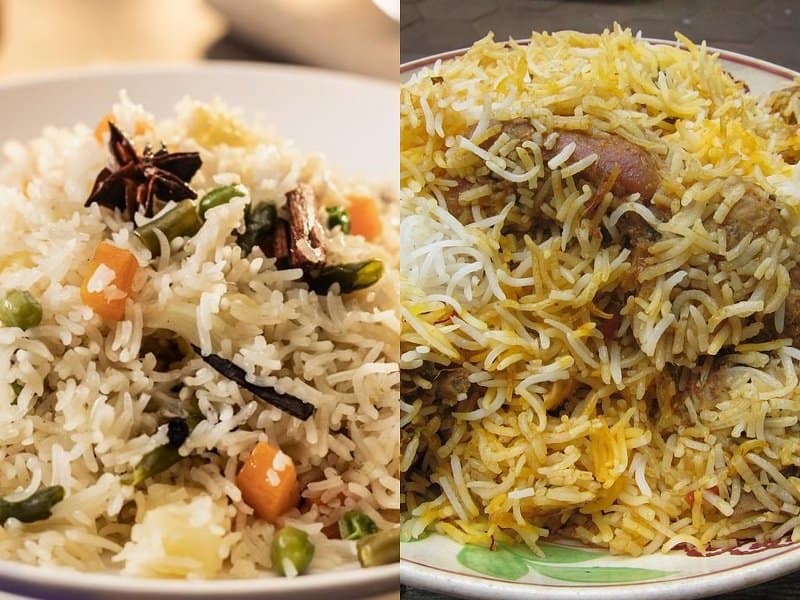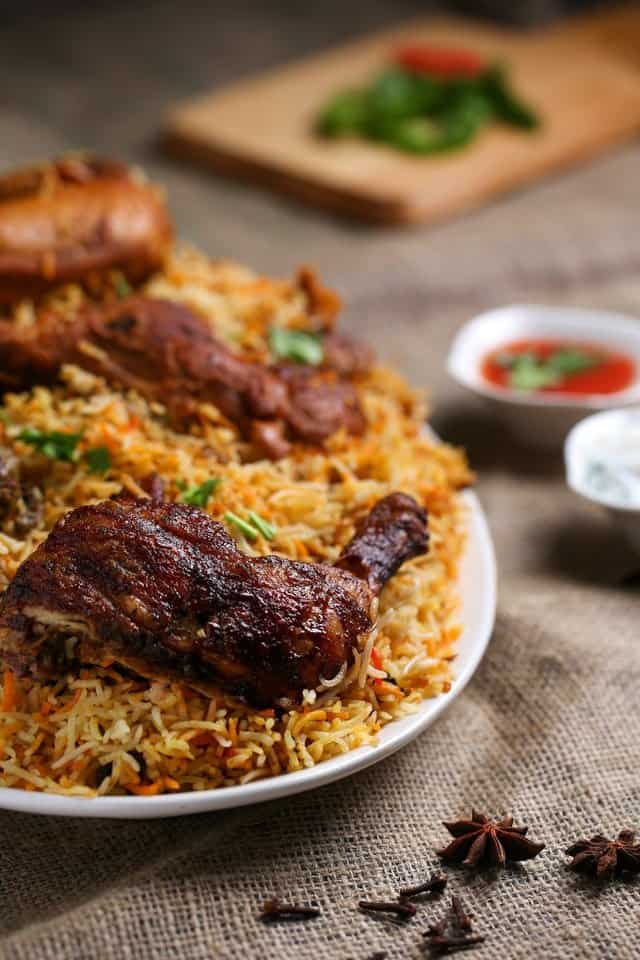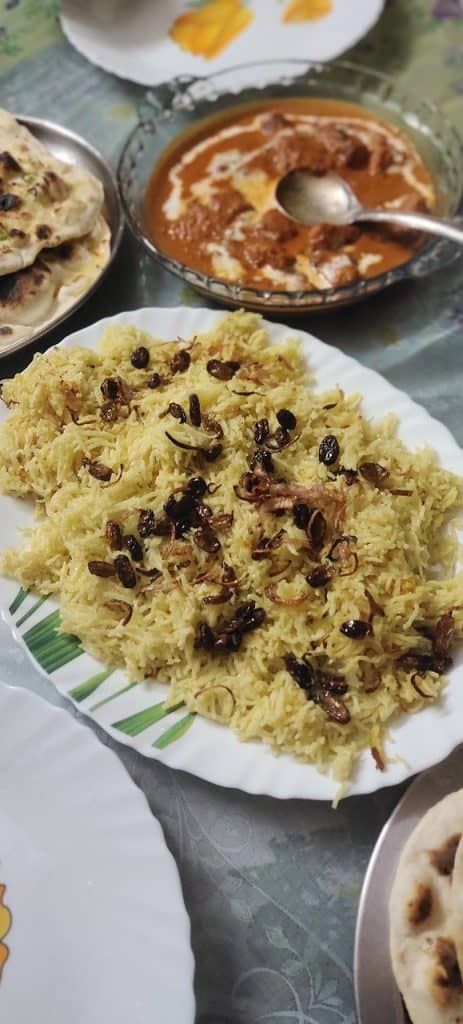When two foods that are similar yet very different hog the limelight then it becomes the talk of the town. Or perhaps I should say that they become the debate of an entire nation. One of the most searched term on internet in India is the difference between Pulao and Biryani. Like the difference between Yogurt and Curd, this one is not an easy topic. Maybe this is a reason that time and again wars have been raged (on twitter) for understanding the difference between Pulao and Biryani.
Irony is rather than bringing the battle heads on the people out there has done injustice to the debate. You know the reason already. The infamous statement lingers in time either through someone’s voice or through written literature. That statement is, “Veg Biryani is nothing but a Pulao.” I now assume that you also might be having an opinion which according to you is right.
I am not a learnt scholar like K.T. Achaya but today I want to take on this debate of difference between Pulao and Biryani to end it from my side and then live in peace. So if you think that Veg Biryani and Pulao are the same then you should specially read this and if you don’t think so then you too are not right. Curious now? Keep reading let’s get this done and dusted today.
Origins of Both Pulao and Biriyani
It is quite evident that Pulao is way older than Biryani. Isn’t it? You tell me what came first? I am sure it is relatively easier question than what came first, chicken or the egg! So if you tickle your brain and know the basics of culinary then your answer will be Pulao. Yes Pulao came first and Biryani was later introduced. Pulao was a one pot dish which comes closer to the primitive cooking techniques of the human evolutionary history.
Biryani is too sophisticated and thus highly unlikely that it came before Pulao. In fact it is quite popular fact that, Pulao which is also called as Pilaf was the true pre-cursor or the Biryani. Both the dishes are made out of same main ingredients. The ingredients are rice, meat, spices and oil or ghee. Yet they remain individually distinct in their own tasty ways.

K.T. Achaya (legendary food historian) has written that, in About 2nd Century, meat cooked with rice was referred to in Yagnavalkya Smriti as ‘Pallao-mevach’ and the word ‘Palao’ also occurs in early Tamil literature of a slightly later period. He also mentions that the Indian epic Mahabharata mentions an instance of rice and meat cooked together. So you will be happy to know that this dish went from India to the other parts of the world and then returned to India again as Pulao and Biryani.
In context of Biryani it is believed that, it was developed in the royal kitchens of Mughal Empire roughly after 1526 CE. Many historians have their own theories with multiple evidences. Some say Arab traders brought the dish to India long before the Mughals. Some say that the dish was developed from the Persian Pilaf. Pratibha Karan (IAS officer and author) thinks that the Pilaf was an Army dish that was easy to cook and a one pot meal which was refined later on in terms of cooking to make it a Biryani.
So now one thing which we can conclude here is that, both the dishes were authentically meat-centric. The vegetable versions were developed after the demands and food choices of people changed over time.
The Difference between Pulao and Biryani
So now coming to the meatier part of today’s blog. Let me tell you that, not one but almost 5 things that differentiates the Pulao and Biryani. If you are decent at cooking then you must be already aware about it. So just read it and then share with someone who is always in a denial mode on this topic.
1. Technique of Cooking
The principal difference between Pulao and Biryani is the technique of cooking involved. Pulao is cooked in a measured amount of water that is enough for cooking the meat and the rice together. The water gets absorbed by the grains of rice completely. Since the water has all the flavours from the meats or vegetables in it, the rice soaks in the wholesome deliciousness and dries up the pot. In making a Pulao the rice and meat cooks together from start to the end.
While Biryani rice is cooked in ample amount of water, this is done so that the rice grain cooks and elongates to give that right feel to Biryani rice. The salty water is boiled and then the presoaked rice grains are added. Once the rice is parboiled and elongated the excess water is drained and the rice is dried.
2. Rice Layers
If you are a Biryani fan then this is the least I can expect from you. You know that Biryani has layers to it. In fact this is a stark difference between Pulao and Biryani. Biryani is made in layers. Some places add rice first then the semi cooked meat, followed by rice layer, topping it with fried onion layer, ghee and mint or coriander leaves. Other places skip the first layer of rice and start with the meat layer.

Pulao is pretty simple as compared to Biryani. Sauté the meat and veggies together, toss the rice in it and then finally add the measured quantity of water and then cook till done. Pulao doesn’t need layering trouble. I am sure as many times you have read it till now, each time you are growing more confident about making a Pulao all by yourself. Am I right?
3. Spices
Pilaf of Pulao which became famous in the Middle East didn’t have much of spices and this is why the Pulao that we make here in India is mildly spiced. Even with the spices you are not allowed to go overboard. Only exception being the Mumbai’s Tawa Pulao which is never mild, and I know you will agree here. All thumb rules have exceptions and so does this one.
Biryani’s soul lies in the spices used. On an average a Biryani has 15 spices that goes into it. I have seen some restaurants which add more than 25 spices in the spice mixture of Biryani. The reason behind this sharp spices is that the rice is cooked with salt and only few aromatic condiments so it is not having a taste of its own and is like a blank canvas ready to be painted with the spiciness.
4. Choice of Vessels
Amateur cooks will often make this mistake. Though it is not a huge difference between Pulao and Biryani but this small thing can define the finesse in your dishes. Each cooking vessel has its own properties and are apt for cooking a specific type of dish.
For Pulao any pot which is narrower than a pan is fine. As all the flavours need to come in the centre where the heat is maximum. Most of the flavours do get released at such high heat and thus Pulao is mostly cooked in pots. I am again saying that it is not hard and fast rule, I have eaten some amazing Pilafs that were cooked in a wide utensil. So you try this and tell me if this works.
Biryani has so much of aromas that need to be developed as the cooking goes on. This is the reason that Biryani and all its layers should be arranged in a wide vessel of cooking. The preferred vessel is called Daig. Daig is wide mouthed pot which has a flat bottom. It is useful in Dum style of cooking as the spacious interiors of Daig holds up the steam and aroma and helps the rice to attain its maximum length. This defines a true Biryani from a mediocre one.
5. Heat
Often sidelined, but this factor can make or break your dish. Many people who try making Biryani for the first time, do falter at this stage. I hope you know that Biryani is supposed to be slow cooked always. The logic says that the spices need to unleash their full flavours in a comparatively dry surrounding. To make this happened slow cooking for longer duration is the key step.
Pulao is generally cooked on a medium to high heat as the dish is finished, once the rice grains absorb the water from the stock. How simple right? Now if you think making Pulao is much easier then I have one challenge for you and that is to make the Zereshk Berry Pulao. That is much challenging than Biryani. Are you up for the challenge? Here is a simple recipe for you if you accept the challenge.
If you want to dig through the layers deeper, then here is a link to one of the best articles on this topic, published on food.ndtv.com
Is Veg Biryani a Pulao?
How often have you heard this? There are two kind of people in the world, one who think that Veg Biryani is a Pulao and not a Biryani. The other kinds thinks why can’t veg Biryani be a thing. So which side are you on? To start on neutral ground, would be fair enough as we will move forward towards the conclusion. Do you have any vegetarian friends whom you would share this with?
Before you reach any conclusion with me, please be aware that the opinions expressed here are my personal views and you can always agree to disagree. So according to me a Veg Biryani is not a Pulao. This statement is purely based on the fact that if all the points mentioned above are followed while cooking then the maker knows what he or she is making. The person who is going to eat also knows what he or she is eating. Then who cares what everyone else think?
There is a famous theory these days which says that a veg Biryani is not even a thing. Then is it a Pulao? The reply from this new clan comes as a big ‘NO’. They say that even if Veg Biryani is not a thing but it is certainly not a Pulao. They say it could be called as a Tehri. Did you know what a Tehri is?
Tehri is the official vegetarian Biryani as most of the people call it. It is officially called Tehri which hails from Gulbarga, Hyderabad and Nanded. Having said this, it is not always that Tehri is strictly vegetarian, some places do add meat of their choice to Tehri. As you explore further you will come to know that each regions serves this dish in their special style.
Like in Awadh the rice is yellow colored. In selected few regions of North India and its neighboring country the Tehri has potatoes which is truly a mouthwatering delicacy. It is also served in the Kashmir region and it is famous as a street food there. Have you ever tried Tehri? Though the visible difference between a Veg Biryani, Veg Pulao and Tehri is diminishingly thin but a food historian can tell you which dish is called what based on his/her knowledge and culinary experiences.
Final words from me are, the way of cooking can define a dish. So if a rice preparation is prepared like Pulao and has vegetables in it then it is a Veg Pulao. If a rice preparation is made royally and has vegetables in it then yes it could be a veg Biryani. The only option for meat lovers here is to call it a Tehri and not just Pulao. You never know, even Pulao must be feeling hurt with this sort of comparisons. So choose your words wisely from here onward.
Closure:
According to me a dish becomes famous from its name. The name which is derived mostly from the way of cooking, the texture, the final appearance and sometimes the ingredients. In case of Biryani and Pulao the preparations are rice based that are cooked along with meat traditionally but over the years, vegetables have been added so that vegetarian people could also enjoy these dishes. Why should non-vegetarians have all the fun?

I hope after reading this blog you now have a better idea about the difference between Pulao and Biryani. I also hope that now you know that Veg Biryani is not a Pulao but it is altogether a different dish which people might prefer calling Tehri. Complicated topics like these are really fun to tame and I plan to do it frequently. In case you have more suggestions or recommendations then do write to me at foodie_khiladi@sh119.global.temp.domains or DM me at foodie_khiladi007.
This topic of debate is not clear to even many chefs and food experts till date, here is a confusing article in case you don’t believe me with this fact. With this I end my blog here and would take your leave. In a hope that you liked this blog and would definitely share it with your friends and loved ones. I will see you soon in my next blog post, till then keep smiling and spreading the smiles.



Hi….khiladi ….I m always reading u r blog and it’s really nice and get interesting to reading I never get bored ☺️ reading ur blog cause I m also little bit like u … love to making n eating food alot.
You are a better chef Rutvik… 😉 I am a rookie… 😉